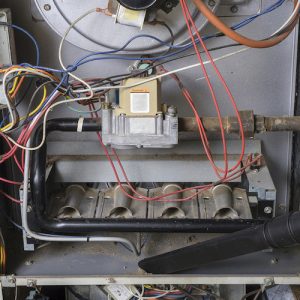Inspecting HVAC Systems
HVAC inspection is a key part of every AIS home inspection in McKinney, Frisco and nearby Dallas communities. Most air conditioners operate on the same basic principle. A compressor takes refrigerant, a gas at room temperature and pressure, and compresses it to 300-400 pounds per square inch or psi. The compression of the gas heats it up a great deal. The hot gas is then sent through a set of condensing coils where it is cooled and condenses. This liquid is then allowed to expand back into a gas in a radiator type device called an evaporator. As air is blown across the evaporator, it is cooled. This cool air is then delivered into the home via air ducts.
Air Conditioning
One way to test the air conditioner is to take the temperature of what comes out of the supply and what goes into the return vents. The difference between these two temperatures should fall between 15-22 degrees. Any temperature reading outside of that range is an indication of a problem. A reading of between 0 and 5 degrees is usually an indication that the unit is not working at all. A reading between 5 and 15 may indicate that the unit is low on Freon. It is not uncommon for the system to need to be recharged with refrigerant every few years. If you get a high reading of above 22 degrees, there may be a blockage of airflow somewhere in the system. A licensed HVAC inspector will need to make a full evaluation of the system in either case.
Gas Furnace HVAC Inspection
Gas fired furnaces heat air by blowing air over a hot heat exchanger. This is a steel vessel that contains the flame and combustion gases above the gas burners. The combustion gases are vented out through the chimney of the furnace.
The steel vessel is subject to thermal cracking and corrosion from acids in the gases, and these are fairly common HVAC inspection issues. Because of this, a serviceman should check the unit a least once a year.
The pilot light should be turned off during the months it is not in use. Heat from the pilot light tends to attract excess moisture into the heat exchanger if left on during a season when the furnace is not being used. The excess moisture in the steel heat exchange can cause the unit to rust and crack. When the heat exchange is cracked, dangerous combustion byproducts will enter the air stream and be circulated throughout the home. If there is any rust or irregular flame pattern observed at the furnace, a serviceman should be contacted.
Inspecting Electric Furnaces
Electric furnaces use a series of heating elements to heat the air. These elements sequence on one at a time and heat the air. There is little to no maintenance necessary with these types of units, and we rarely find problems in our HVAC inspection work. A heat pump reverses the refrigerant cycle of the air conditioner to carry the heat into the house. It also incorporates a two part electric furnace.
One series of heating elements turns on, when needed, to help the heat pump produce heat. An emergency switch located on the thermostat controls the second series of heating elements. These heating elements will provide heat if the actual heat pump goes is not working. The emergency heat mode should only be used to get by until a serviceman can repair the unit.
Call AIS today – TREC-Certified Inspector
Mike Martin (972) 342-9183
